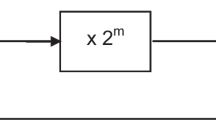Abstract
In recent years, chaotic systems are widely used in the secured transmission of images due to the inherent properties relevant to cryptography. In this article, a novel encryption algorithm based on hyperchaotic system is proposed. The algorithm employs a five dimensional (5D) hyperchaotic system with quadratic nonlinearity. The cryptographic operations such as confusion and diffusion are performed in an innovative way. Hybrid random matrix transform (HRMT) is proposed to perform confusion operation which is controlled by 5D hyperchaotic system. The algorithm is validated by presenting extensive simulation results and comparisons. The results show that the algorithm is capable of resisting various kinds of attacks.







Similar content being viewed by others
References
Abd-El-Atty, B., Abd El-Latif, A. A., & Venegas-Andraca, S. E. (2019). An encryption protocol for NEQR images based on one-particle quantum walks on a circle. Quantum Information Processing, 18(9), 1–26.
Fu, C., Zhang, G. Y., Zhu, M., Chen, Z., & Lei, W. M. (2018). A new chaos-based color image encryption scheme with an efficient substitution keystream generation strategy. Security and Communication Networks, 1, 1–13.
Hanchinamani, G., & Kulkarni, L. (2015). An efficient image encryption scheme based on a Peter De Jong chaotic map and a RC4 stream cipher. 3D Research, 6(3), 1–15.
Huang, Z. J., Cheng, S., Gong, L. H., & Zhou, N. R. (2020). Nonlinear optical multi-image encryption scheme with two-dimensional linear canonical transform. Optics and Lasers in Engineering, 124, 105821.
Kaur, J., & Jindal, N. (2019). A secure image encryption algorithm based on fractional transforms and scrambling in combination with multimodal biometric keys. Multimedia Tools and Applications, 78(9), 11585–11606.
Kocarev, L. (2001). Chaos-based cryptography: a brief overview. IEEE Circuits and Systems Magazine, 1(3), 6–21.
Li, F., Wu, H., Zhou, G., & Wei, W. (2019). Robust real-time image encryption with aperiodic chaotic map and random-cycling bit shift. Journal of Real-Time Image Processing, 16(3), 775–790.
Liu, L., Hu, H., & Deng, Y. (2015). An analogue–digital mixed method for solving the dynamical degradation of digital chaotic systems. IMA Journal of Mathematical Control and Information, 32(4), 703–716.
Liu, L., & Miao, S. (2018). A new simple one-dimensional chaotic map and its application for image encryption. Multimedia Tools and Applications, 77(16), 21445–21462.
Mandal, M. K., Banik, G. D., Chattopadhyay, D., & Nandi, D. (2012). An image encryption process based on chaotic logistic map. IETE Technical Review, 29(5), 395–404.
Preishuber, M., Hutter, T., Katzenbeisser, S., & Uhl, A. (2018). Depreciating motivation and empirical security analysis of chaos-based image and video encryption. IEEE Transactions on Information Forensics and Security, 13(9), 2137–2150.
Rukhin, A., et al., (2001) A statistical test suite for random and pseudo-random number generators for cryptographic applications, NIST Special Publication 800–22.
Schneier B (1996) Applied cryptography, protocols, algorithms and source code in C. Wiley, New York.
Shannon, C. E. (1949). Communication theory of secrecy systems. The Bell System Technical Journal, 28(4), 656–715.
Sui, L., Duan, K., Liang, J., & Hei, X. (2014). Asymmetric double-image encryption based on cascaded discrete fractional random transform and logistic maps. Optics express, 22(9), 10605–10621.
Talhaoui, M. Z., Wang, X., & Midoun, M. A. (2020). Fast image encryption algorithm with high security level using the Bülban chaotic map. Journal of Real-Time Image Processing, 18(1), 1–14.
Tang, J., Yu, Z., & Liu, L. (2019). A delay coupling method to reduce the dynamical degradation of digital chaotic maps and its application for image encryption. Multimedia Tools and Applications, 78(17), 24765–24788.
Wang, X., Feng, L., Li, R., & Zhang, F. (2019). A fast image encryption algorithm based on non-adjacent dynamically coupled map lattice model. Nonlinear Dynamics, 95(4), 2797–2824.
http://sipi.usc.edu/database/database.php
Wang, Z., & Bovik, A. C. (2002). A universal image quality index. IEEE Signal Processing Letters, 9(3), 81–84.
Wang, Z., Bovik, A. C., Sheikh, H. R., & Simoncelli, E. P. (2004). Image quality assessment: from error visibility to structural similarity. IEEE Transactions on Image Processing, 13(4), 600–612.
Xu, L., Li, Z., Li, J., & Hua, W. (2016). A novel bit-level image encryption algorithm based on chaotic maps. Optics and Lasers in Engineering, 78, 17–25.
Yang, Q., & Bai, M. (2017). A new 5D hyperchaotic system based on modified generalized Lorenz system. Nonlinear Dynamics, 88(1), 189–221.
Ye, H. S., Zhou, N. R., & Gong, L. H. (2020). Multi-image compression-encryption scheme based on quaternion discrete fractional Hartley transform and improved pixel adaptive diffusion. Signal Processing, 175, 107652.
Zhang, M., & Tong, X. (2014). A new chaotic map based image encryption schemes for several image formats. Journal of Systems and Software, 98, 140–154.
Zhang, X., Wang, L., Cui, G., & Niu, Y. (2019). Entropy-based block scrambling image encryption using DES structure and chaotic systems. International Journal of Optics., 2019, 1–13.
Zhang, Y., & Tang, Y. (2018). A plaintext-related image encryption algorithm based on chaos. Multimedia Tools and Applications, 77(6), 6647–6669.
Zhou, N., Jiang, H., Gong, L., & Xie, X. (2018). Double-image compression and encryption algorithm based on co-sparse representation and random pixel exchanging. Optics and Lasers in Engineering, 110, 72–79.
Zhou, Y., Bao, L., & Chen, C. P. (2013). Image encryption using a new parametric switching chaotic system. Signal Processing, 93(11), 3039–3052.
Zhou, Y., Hua, Z., Pun, C. M., & Chen, C. P. (2014). Cascade chaotic system with applications. IEEE Transactions on Cybernetics, 45(9), 2001–2012.
Author information
Authors and Affiliations
Corresponding author
Additional information
Publisher's Note
Springer Nature remains neutral with regard to jurisdictional claims in published maps and institutional affiliations.
Rights and permissions
About this article
Cite this article
Sheela, S.J., Sanjay, A., Suresh, K.V. et al. Image encryption based on 5D hyperchaotic system using hybrid random matrix transform. Multidim Syst Sign Process 33, 579–595 (2022). https://doi.org/10.1007/s11045-021-00814-8
Received:
Revised:
Accepted:
Published:
Issue Date:
DOI: https://doi.org/10.1007/s11045-021-00814-8




